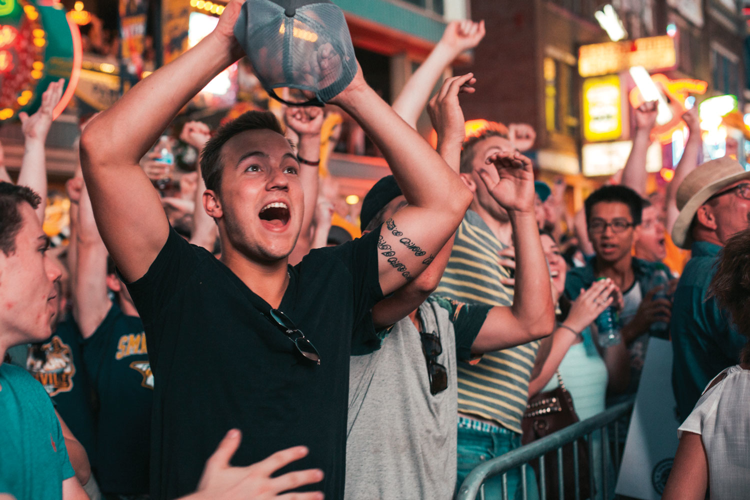
It was March 27, 2010, and the Nashville Predators were tied 0-0 after three periods of play against the Detroit Red Wings. Back then, the boys in gold were the boys in navy blue, Bridgestone Arena was the Sommet Center, Barry Trotz was head coach, and Jason Arnott wore the C. Even though I lived 2,400 miles away in Seattle, I’d been following the team for a couple seasons. But I’d never gotten to see a game live, and oh my God, was it exciting to finally be standing in Smashville.
The teams remained scoreless in overtime, and the game went into a shootout. I looked up at my boyfriend of two years — the Nashvillian who turned me, a lifelong Pacific Northwesterner, into a Preds fan — and probably said something like, “Holy shit, this is amazing!”
It wasn’t my first hockey game (go Everett Silvertips!), but it was my first NHL hockey game, and the shootout went … on … for … ever. Todd Bertuzzi, the fifth shooter for the Red Wings, scored on Pekka Rinne — gasp! — but then Steve Sullivan saved us by getting one past Jimmy Howard, and the crowd exploded in cheers. The momentum built, the tension thickened, everyone was on their feet, booing each attempt by the Red Wings, sitting in hopeful silence each time a Pred rushed the net.
Cody Franson took a turn for the Preds, as did Patric Hornqvist, J.P. Dumont and Colin Wilson — both teams burned through five more shots. Booing, cheering, booing, cheering. Then Niklas Krowall’s 11th-round attempt for the Red Wings slipped through Rinne’s legs, Howard blocked Francis Bouillon’s attempt to answer, and it was over. The Preds lost.
I was hooked. The thrill, the speed, the skill, the luck — the taunting chants radiating from Section 303 and the lingering crowd of fans still ecstatic about the ride, even in the face of a loss to one of their longtime rivals.
I returned to Seattle but maintained a long-distance relationship with the team. I married that guy who took me to my first Preds game, and together we watched Shea Weber become captain, saw the jerseys go from blue to gold, said goodbye to Barry Trotz and hello to Peter Laviolette, and then said goodbye to Weber and hello to P.K. Subban.
When we moved to Nashville at the end of 2013, I was thrilled to say I live in a hockey town, my hockey town. I was finally and officially a Smashvillian.
You probably remember your first Preds game, too. Maybe it was the franchise’s first game ever on Oct. 10, 1998. Maybe it was in 2008, when the tradition of our infamous uproarious standing ovation during a TV timeout was started. Maybe it was earlier this year, or even last week.
As soon as the Predators started the playoffs by sweeping (!) the Chicago Blackhawks, the narrative began — commentators and hockey heads started complaining that Nashville, the team and the city, isn’t the real deal. They struggled to make sense of how their playoff brackets could be so busted so quickly.
Who could see this coming?
P.K. Subban’s a clown!
Nashville’s not a real hockey town.

But what are people really saying when they say Nashville isn’t a “hockey town”? People in the South are too dumb to know what icing is? We don’t “deserve” hockey because it gets hot here (like it doesn’t hit 90 degrees in Pittsburgh in June)? We don’t fit into your idea of what a professional-sports town is because our fans and players like to (love to) have a little fun?
We have been bumbling through the NHL since Day 1, proudly creating our own traditions while embracing every mishap. A 2013 email sent out to the entire Preds fan mailing list ended with the typo “Go Perds!” Embarrassing? Sure. Even ESPN made fun of us. But fans, and the franchise, will occasionally refer to the Preds as “the Perds” to this day.
Some say there’s no room for catfish and cowboy hats in the NHL, and Nashville responds by strapping a glitter-covered 10-gallon on a bottom-feeder before tossing it onto the ice. Some say hockey is being wasted on a quiet little city in the South, and we respond by selling out an entire season, breaking noise and broadcast records with our nontraditional chants and swiftly growing fan base. They call us rednecks, we coin the phrase “Predneck.” They say we don’t understand hockey’s traditions, so we put on a show so big that people show up to games hours early.
This attitude, this refusal to be ashamed, has always existed.
In 2016, when Nashville hosted the All-Star Weekend, the league got its first real taste of how powerful Smashville could be. John Scott, an unremarkable Arizona Coyotes player with only five goals in his career, was chosen by fans as Pacific Division captain. Soon after he won the internet vote, his team traded him to the Canadiens, and they sent Scott down to the American Hockey League. He didn’t fit into the All-Star story, he wasn’t a star, so the league asked Scott to remove himself from the game, but he refused. When Scott took the ice in Nashville, he got a lengthy standing ovation, and when it came time to vote for the weekend’s Most Valuable Player, NHL commissioner Gary Bettman tried to block Scott from winning by keeping him off the ballot. But everyone in Bridgestone Arena chanted his name at the top of their lungs until it was undeniable that he was, indeed, the MVP. The NHL had no choice but to make him the winner as a write-in candidate. Seeing him skate across the ice to accept his award — after turning to his teammates, pointing at himself and asking, “Me?” to make sure it was real — was one of the most uplifting scenes I’ve ever witnessed.
My entire body was flush with that same sense of pride this June — hockey in Nashville in June! — as I saw that attitude, that air of rebelliousness that has been a part of Smashville’s story since Day 1, grow to new heights. Finally, not following the rules and not doing what was expected paid off, and the Predators were the Western Conference champions.
As the Preds eliminated the Blackhawks, and then the Blues, and then the Ducks, I watched tens of thousands of people feel that same flutter in their hearts that I experienced when I watched Rinne and the boys battle through an 11-round shootout. I high-fived strangers wearing gold T-shirts on the street. I bonded with typically reserved co-workers over disdain for Patrick Kane and Ryan Kesler. I gleefully woo’d back at pedal taverns carrying fellow Preds fans, for chrissakes.
There’s something beautiful, awe-inspiring even, in watching an entire city throw on their cowboy boots (proverbial or otherwise), stock up on catfish and say, “Oh yeah? Says who!” when the rest of the world is pointing, laughing and saying, “You shouldn’t be here.” I felt that same fearlessness as we went into Game 6 against the Penguins. It was do-or-die time, everyone said. It was all or nothing. My heart started racing as soon as the puck dropped, but I pulled my eyes away from the ice to take a look around — I looked at those familiar faces I’ve been sitting amid through the entirety of the playoffs, the same season ticket holders who’ve been dreaming of seeing a Stanley Cup Final game in their own town. I knew, win or lose, Smashville — hell, the entire NHL — would never be the same again. The rules have changed, and Nashville has changed them.
I don’t need to tell you how it ended. I don’t want to think about how it ended. But as the Preds took to center ice one last time for Game 6, lifting their sticks in the air as a gesture of gratitude for the fans who have stood by them for decades — or for weeks, or even just for days — the gold-filled arena was filled with chants of “Thank you, Predators!” It wasn’t the win they wanted, it wasn’t the win we wanted. But it was a loss that got me hooked in the first place, too. I know now, for a whole new generation of Nashvillians near and far, the story has only just begun.






